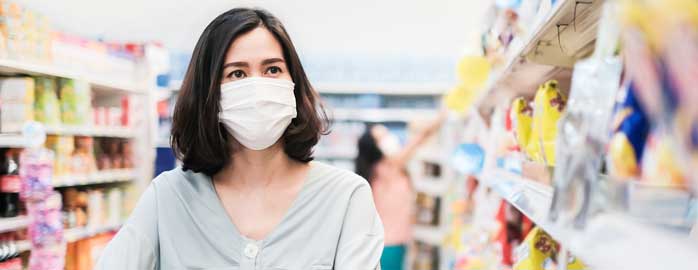
by Bobby Marhamat
Savvy retailers recognize that the tactics which served them well before the COVID-19 pandemic may not lead to the same success in a post-pandemic world. As consumers become increasingly selective about where they spend their time while out and about, stores must create the best in-store experiences possible to woo the masses.
This focus on experience should not surprise anyone who has worked in retail for the last 10 years. After the ecommerce boom, stores needed a way to differentiate themselves from the convenience of online offerings. In Raydiant’s first report this year, The State of Consumer Behavior 2020, we found that customers still prefer to shop in person for all sorts of reasons and items. Since we released that report in January, though, the world has changed.
The coronavirus made customers more concerned than ever for their safety in public places, such as retail shops and restaurants. In the new post-pandemic world, retailers must redouble their efforts to provide engaging, meaningful customer experiences. That doesn’t mean adding a petting zoo next to the cash register, though. Consumers don’t necessarily want the wild and exotic, but the functional, helpful, and convenient. In the reopening of retail, a truly great in-store experience eliminates friction to make customers feel both safe and satisfied.
In June 2020, we conducted a new survey of more than 400 retail store owners to understand how they plan to approach the reopening of retail. Our research, compiled in our Reopening of Retail Report, discovered five areas in which retailers plan to invest.
Tools to Help Train Associates (54%)
Earning the top spot by a slight margin, we found that most retailers intend to invest in tools to help train associates in a post-lockdown world. Stores that plan to reopen must not only contend with new cleaning policies, but must also address issues of convenience and experience. Some stores plan to focus more on their websites and digital-physical integrations, while others expect customers to perform delivery driver duties.
In all cases, the task of carrying out the actions mandated by regulators falls to the frontline workers. Tools such as modifiable digital signage, training software, and communication facilitators can all help employees learn more quickly and stay vigilant regarding new processes.
Tools to Improve In-Store Experiences (50%)
Retailers already know the importance of great in-store experiences. Today’s customers expect more than just products on shelves. They expect stores to meet their needs of convenience and personalization, and in some cases, to go above and beyond with experiences that delight. To address those needs, half of our surveyed retailers expect to invest in technology that improves the customer experience.
The implementation of experience tools depends on the industry. A restaurant, for example, might use a helpful smartphone integration system to streamline seating and order pickup. A clothing outlet could put up digital signs to advertise special deals based on data gathered from customers’ smartphones. The only limit is the imagination of the retailer.
Tools to Limit Interpersonal Contact (50%)
Thanks to the pandemic, people now pay more attention to how much time they spend in physical proximity to others. Warnings from health authorities have made people keen to avoid contact whenever possible. Retail stores, which don’t always have the luxury of extra space, must think carefully about how they design their spaces to minimize contact.
Tools don’t always have to be expensive technology. Retailers can use the shelves and other items they have on hand to design pathways that limit the need for contact. Simple screens between cashiers and customers can prevent unnecessary closeness. Technologies like contactless payment methods can help as well.
Tools to Improve Online Experiences (33%)
Our research found that many retailers used the opportunity of the shutdown to invest more in their online presences. As the reopening of retail commences, stores that invested in their websites will not want to waste all the effort they spent on their digital storefronts.
Brick-and-mortar retailers learned long ago that they cannot compete with ecommerce if they don’t have any online presence whatsoever. Factors such as local SEO, updated Google listings, and on-site features all help persuade consumers to shop in stores. The retail industry will likely see an uptick in helpful online tools like chatbots in the wake of the pandemic.
Tools to Create Seamless Online-to-Offline Experiences (24%)
The reopening of retail presents a golden opportunity for more retailers to boost the in-store experience with digital-physical integrations. By blurring the line between the digital and the physical, brick-and-mortar retailers can provide a unique experience that solely ecommerce brands cannot match.
Take curbside pickup, for example. Customers could order online, use their smartphones to notify the store of their arrival, and receive their products with minimal human contact. Stores can also leverage online positions to deepen customer loyalty with discounts and incentives to return in person.
While new tools will undoubtedly play a large part in the future of physical shopping, our research revealed several more interesting trends in the reopening of retail. Check out the full report to learn how retail business owners plan to tackle this next challenge.
Bobby is the CEO of Raydiant, a digital signage provider that helps businesses turn their TVs into interactive signs that drive sales, improve the in-store experience, and reinforce brand messaging. Prior to joining Raydiant, Bobby served as the COO of Revel Systems where he worked on the front lines with over 25,000 brick and mortar retailers. Bobby has held leadership positions including CEO, CRO, and VP of Sales at companies such as Highfive, Limos.com, EVO2, Verizon Wireless, LookSmart, ServerPlex Networks, and Sprint/Nextel. When Bobby’s not spending his time thinking about the future of brick and mortar retail, you can find him traveling, reading, or tending to his vegetable garden.